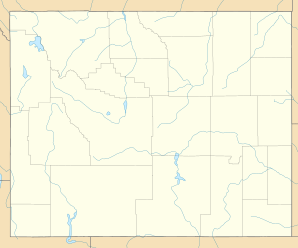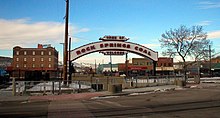Rock Springs, Wyoming
| Rock Springs | ||
|---|---|---|
|
Location in Wyoming
|
||
| Basic data | ||
| Foundation : | 1888 | |
| State : | United States | |
| State : | Wyoming | |
| County : | Sweetwater County | |
| Coordinates : | 41 ° 35 ′ N , 109 ° 13 ′ W | |
| Time zone : | Mountain ( UTC − 7 / −6 ) | |
| Residents : | 23,036 (as of 2010) | |
| Population density : | 421.1 inhabitants per km 2 | |
| Area : | 47.87 km 2 (approx. 18 mi 2 ) of which 54.7 km 2 (approx. 21 mi 2 ) is land |
|
| Height : | 1947 m | |
| FIPS : | 56-67235 | |
| GNIS ID : | 1593588 | |
| Website : | www.rswy.net | |
Rock Springs is a city in Sweetwater County , Wyoming, United States . The town, located at 2060 m above sea level, had 18,708 inhabitants in 2000 and 23,036 in 2010. Rock Springs covers an area of 47.87 km².
Today there are numerous oil and gas production companies.
history
Shoshone and Ute initially lived in the urban area , but the lack of water prevented long-term settlement. In 1850, however, a military expedition led by Captain Howard Stansbury discovered coal in the area. In the 1860s there were contacts between local Cheyennes and Euro-Americans.
From 1869 a place arose that gained a certain importance for traffic connections. While it had only 40 inhabitants in 1870, there were already 763 ten years later.Scandinavian and British miners began to organize and went on strike in 1875, whereupon the Coal Company (UPCC) hired Chinese, whose immigration to the USA was banned in 1882.
The place came into the headlines of the American press because of the Rock Springs massacre of September 2, 1885, in which about 150 striking miners of the Union Pacific coal mine murdered 28 Chinese and burned 75 of their houses. For years the miners have tried to organize themselves and to work for an improvement in working conditions. But the powerful Union Pacific railroad brought Chinese strikers to the region instead. A small Chinatown was created . When the railway company gave the Chinese the best seats, the remaining miners began to attack their quarters. Most of the Chinese were able to flee to the surrounding mountains, but the rest were seriously injured or killed.
On September 9, the army brought the Chinese back and 45 of the white miners were released. There was never a lawsuit. Until the First World War , numerous Chinese stayed in the city and celebrated their kite festival every year. This was probably due to the fact that the UPCC was now hiring Austrians and Slavs, Italians and Greeks, and soon also Koreans and Japanese or Mexicans.
From 1890, the population of the coal, later oil and gas city rose accordingly. It rose to 4,363 from 3,406 to 1900, to 5,778 by 1910 and to 8,440 by 1930. In 1925, when the federal government showed a tendency towards segregation and thus promoted racist trends, the local Baptist priest Steven Pyle convinced the Lions Club to celebrate its first International Night. In 1928 it had grown so big that it had to take place in the theater. For the first time, diversity was propagated as a worthwhile goal.
Neither the global economic crisis nor the Second World War interrupted the population development (1940: 9,827, 1950: 10,857 inhabitants). It did not stagnate until the 1960s, but in 1980 the place had 19,458 inhabitants.
Personalities
- Boyd Dowler (born 1937), American football player
literature
- Timothy Dean Draper: "A little kingdom of mixed nationalities". Race, Ethnicity, and Class in a Western Urban Community. Rock Springs, Wyoming, 1869-1929 , PhD, Northern Illinois University 2007.
Web links
- Rock Springs Wyoming
- Rock Springs Photos. From Wyoming Tales and Trails , archive.org, February 5, 2015
- Complete Historic Architecture Inventory (PDF, 22.6 MB)

